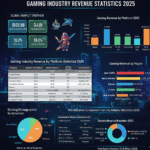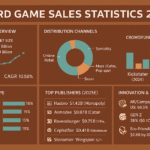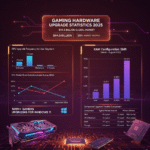Steam Game Statistics 2025
Steam continues its remarkable dominance in the PC gaming industry throughout 2025, establishing new benchmarks for digital game distribution platforms worldwide. The platform has achieved unprecedented concurrent user numbers while maintaining exceptional engagement rates that showcase its central role in modern gaming.
The latest data confirms Steam’s position as the most influential digital storefront for PC gamers, with active user counts reaching historic highs. These statistics reflect broader shifts in how players consume gaming content, driven by both technological advancement and evolving player preferences across global markets.
Steam Concurrent Users Peak in 2025
The platform reached an extraordinary milestone on October 12, 2025, recording 41.6 million concurrent users simultaneously online. This achievement represents the highest peak in Steam’s history and demonstrates sustained growth momentum throughout the year.
Previous records show consistent upward trajectory, with the platform surpassing 40 million concurrent users for the first time in March 2025. The steady increase from 39.3 million in late 2024 to over 41 million within ten months highlights robust expansion across all regions and demographics.
Peak usage periods typically coincide with major game launches, seasonal events, and regional gaming prime time overlap. The October record occurred during the competitive landscape of PC gaming distribution, where Battlefield 6 and other anticipated releases drove exceptional traffic to the platform.
Historical Growth Patterns
The concurrent user base has expanded approximately 500 percent since January 2013, when Steam recorded 6.6 million peak users. This growth trajectory accelerated notably after 2020, adding roughly 20 million users between early 2020 and late 2025.
The platform typically adds between one and two million to its peak concurrent count annually under normal circumstances. Major releases can trigger short-term surges of five to fifteen percent above baseline levels during launch windows.
Steam Monthly Active Users and Daily Engagement
Steam maintains approximately 132 million monthly active users as of 2025, representing the total number of unique accounts accessing the platform within a 30-day period. This substantial user base positions Steam as one of the largest gaming platforms globally.
Daily active users average 69 million throughout 2025, yielding an impressive engagement ratio of 52.27 percent. This metric indicates that more than half of all monthly users access Steam daily, demonstrating exceptional platform loyalty and regular usage patterns.
| User Metric | 2025 Value | Significance |
|---|---|---|
| Monthly Active Users | 132 million | Total unique monthly accounts |
| Daily Active Users | 69 million | Average daily logins |
| DAU/MAU Ratio | 52.27% | High retention indicator |
| Peak Concurrent Users | 41.6 million | October 2025 record |
The high daily-to-monthly ratio reflects strong user retention and habitual engagement. Unlike platforms with lower ratios, Steam benefits from its position as both a game launcher and social hub, encouraging frequent access beyond active gameplay sessions.
User Growth Projections
Industry analysts project monthly active users could reach 140 to 145 million by the end of 2025, based on current growth rates and historical trends. Concurrent user peaks may approach 45 million during major holiday periods and blockbuster release windows in the fourth quarter.
Steam Game Library and Catalog Statistics
The platform hosts over 200,000 games globally, making it the largest digital game distribution service by catalog size. This extensive library encompasses everything from indie titles to major franchise releases, providing unprecedented choice for consumers.
During 2024, Steam added 18,626 new games to its global catalog, averaging approximately 51 new releases daily. This prolific content pipeline continues into 2025, with developers attracted by Steam’s massive user base and established discovery mechanisms.
The United States catalog specifically contains approximately 239,558 titles as of 2025, reflecting regional availability variations and localization factors that affect which games appear in different markets.
Similar to Discord’s growth in gaming communities, Steam’s catalog expansion supports diverse gaming preferences and niche genres that might struggle on more curated platforms. The sheer volume creates challenges for discovery but also enables long-tail monetization for smaller developers.
Operating System Distribution on Steam
Windows maintains overwhelming dominance among Steam users, accounting for 95.45 percent of the platform’s operating system share as of May 2025. This near-universal adoption reflects both gaming software compatibility and hardware market realities.
Linux and SteamOS combined reached 2.69 percent market share in May 2025, marking the highest recorded percentage since at least 2018. This growth correlates directly with Steam Deck adoption and Valve’s continued investment in Proton compatibility layers.
macOS accounts for 1.85 percent of Steam users, representing Apple’s smaller but stable presence in the gaming market. The percentage has remained relatively consistent despite Apple Silicon transitions and increased gaming capabilities in recent Mac hardware.
Hardware Trends Within Steam
The Steam Hardware Survey reveals increasing adoption of high-resolution displays, with more users running games at 2560×1440 resolution compared to previous years. This shift indicates broader hardware improvements across the user base.
GPU statistics show gradual migration toward current-generation graphics cards, though mid-range and older hardware remains prevalent. The accessibility of gaming across various hardware configurations contributes to Steam’s broad appeal beyond enthusiast segments.
Notable Game Releases and Peak Player Counts
Monster Hunter Wilds achieved extraordinary success on Steam, reaching approximately 1.38 million concurrent players shortly after its February 28, 2025 launch. This performance established it as the fifth highest peak in Steam’s history for any single title.
The game shattered previous Monster Hunter franchise records, exceeding Monster Hunter World’s peak of 334,000 by over 300 percent. This breakout performance demonstrates growing mainstream appeal for the series beyond its traditional enthusiast base.
| Game Title | Peak Concurrent Players | Notable Achievement |
|---|---|---|
| Monster Hunter Wilds | 1.38 million | 5th highest Steam peak ever |
| Counter-Strike 2 | 1.86 million | April 2025 record |
| R.E.P.O. | 459,075 | Strong indie performance |
| Assassin’s Creed Shadows | 64,825 | Franchise Steam record |
Counter-Strike 2 continued its dominance throughout 2025, setting multiple concurrent player records. The competitive shooter reached an all-time peak of 1.86 million on April 12, 2025, driven by major tournament cycles and consistent content updates.
R.E.P.O. demonstrated strong independent title performance, peaking at 459,075 concurrent users in April 2025. Schedule I, another highly-rated 2025 release, matched this figure, showcasing that compelling indie games can achieve significant reach on the platform.
Franchise Milestones
Assassin’s Creed Shadows set a franchise record for Steam with 64,825 concurrent players during its first weekend. While modest compared to other major releases, this represented the highest concurrent count for any Assassin’s Creed title on the platform, indicating growing Steam adoption for Ubisoft properties.
The diversity of successful releases across budgets and genres mirrors trends seen in mobile gaming’s evolving landscape, where both blockbusters and innovative smaller titles find substantial audiences through effective platform distribution.
Generative AI in Steam Game Development
One in five Steam games released during 2025 incorporate generative AI technology in some capacity, whether for code assistance, art asset generation, or procedural content creation. This represents approximately 7,818 titles using AI tools in their development pipeline.
These AI-assisted games account for roughly seven percent of Steam’s entire library as of mid-2025. The adoption rate has accelerated dramatically, with year-on-year growth of approximately 681 percent compared to 2024 figures.
The rapid integration of AI tools reflects broader industry trends toward efficiency gains and creative augmentation. Developers leverage these technologies for various purposes including texture generation, dialogue writing, quest design, and quality assurance testing.
Critics raise concerns about artistic originality and labor implications, while proponents emphasize accessibility benefits for smaller teams with limited resources. The debate parallels discussions around AI in other creative industries but manifests uniquely within game development contexts.
Developer Adoption Patterns
Independent developers show higher adoption rates of generative AI tools compared to major studios, which often maintain established art pipelines and proprietary technologies. The accessibility of AI services lowers barriers to entry for solo developers and small teams.
Generative AI usage correlates with specific game types, particularly prevalent in casual games, puzzle titles, and simulation experiences where procedural content provides replayability value. Narrative-focused games utilize AI for dialogue variation and dynamic storytelling elements.
Steam Market Share in PC Gaming Distribution
Steam commands approximately 74 percent of the global PC gaming digital distribution market, maintaining its position as the clear industry leader. This dominance stems from network effects, extensive library, and entrenched user behavior patterns developed over two decades.
The platform generated 10.8 billion dollars in revenue during 2024, representing 24.14 percent growth year-over-year. This financial performance underscores Steam’s commercial viability despite competitive pressures from alternative storefronts and subscription services.
Epic Games Store holds the second position with substantially lower market share but growing influence through exclusive releases and developer-friendly revenue splits. The competitive dynamic benefits consumers through pricing pressure and feature innovation across platforms.
Revenue Distribution Model
Steam operates on a 70/30 revenue split for most titles, with developers and publishers receiving 70 percent of sales revenue. This standard has faced criticism in recent years, particularly as Epic Games Store offers an 88/12 split favoring creators.
Despite less favorable terms, many developers prioritize Steam due to its massive user base, robust community features, and established discovery mechanisms. The platform’s wishlist system, user reviews, and recommendation algorithms provide marketing value beyond pure revenue percentages.
The financial dynamics resemble those discussed in console revenue comparisons, where platform ecosystem value often outweighs individual transaction margins for content creators.
Geographic Distribution and Global Reach
Steam supports 28 languages across its interface and store pages, enabling access for players worldwide. English represents 36.87 percent of the user base, while Simplified Chinese accounts for 24.5 percent, reflecting substantial Asian market penetration.
The Asia-Pacific region contributes 42 percent of Steam’s total user base, with significant concentrations in China, South Korea, and Southeast Asian markets. North America holds approximately 30 percent, while Europe accounts for roughly 25 percent of global users.
Regional pricing strategies enable Steam to maintain accessibility across diverse economic contexts. Games often feature adjusted pricing for lower-income markets, balanced against restrictions on cross-region key activation to prevent arbitrage.
Time Zone Coverage
The global distribution allows Steam to maintain high concurrent user counts throughout 24-hour cycles, as peak gaming hours rotate across time zones. This continuous activity differs from more regionally concentrated platforms that experience pronounced daily fluctuation.
Major Asian markets contribute substantially to weekday peaks, while North American and European usage drives weekend highs. The geographic diversity provides stability for developers launching titles, as releases can gain traction across multiple regions sequentially.
Steam Competitor Analysis and Industry Context
The digital game distribution market projects growth from 1.09 billion dollars in 2024 to 1.58 billion by 2033, representing a compound annual growth rate of 4.2 percent. This expansion reflects continued digitalization of game sales and declining physical media relevance.
Over 95 percent of game sales now occur through digital channels, with physical retail relegated to niche categories and collector editions. This shift benefits established platforms like Steam that built infrastructure and user bases before the digital transition accelerated.
Microsoft’s Game Pass subscription service presents an alternative model emphasizing access over ownership, though Steam’s traditional purchase-based approach remains dominant. The coexistence of subscription and purchase models provides consumers flexibility while creating strategic questions for publishers.
Competitive Differentiation
Steam maintains advantages through community features, including user-generated content workshops, discussion forums, and social connectivity tools. These elements create switching costs as users accumulate friends lists, reviews, and curated collections over years of platform engagement.
Cloud save synchronization, achievement tracking, and trading card systems add marginal value that compounds over time. New competitors struggle to replicate these network effects despite potentially superior individual features or financial terms.
The competitive dynamics parallel competitive gaming platforms and esports infrastructure, where established ecosystems resist disruption despite emerging alternatives with specific technical advantages.
Steam Community and Social Features
Steam’s community infrastructure extends beyond game distribution into social networking for gamers. Discussion forums, user reviews, and content sharing create engagement loops that keep users returning to the platform between gaming sessions.
User reviews influence purchasing decisions substantially, with the review system allowing filtering by purchase verification, playtime, and review date. This transparency helps consumers navigate the massive catalog while providing developers feedback channels.
Workshop functionality enables user-generated content distribution for supported games, extending title longevity and fostering creative communities. Games like Skyrim and Civilization benefit enormously from extensive mod ecosystems hosted through Steam Workshop.
Broadcasting and Streaming Integration
Steam Broadcasting allows users to stream gameplay directly to friends through the platform, though it faces competition from dedicated services like Twitch and YouTube Gaming. The integration provides convenience for casual streaming without external account requirements.
The social features contribute to Steam’s high daily active user ratio, as players log in to chat with friends, browse community content, and participate in events even when not actively gaming. This expanded utility beyond pure game launching differentiates Steam from simpler distribution platforms.
Steam Sales Events and Marketing Strategies
Seasonal sales events generate significant traffic spikes and purchasing activity throughout the year. Major sales periods include summer and winter events, typically featuring discounts across thousands of titles with highlighted daily deals.
The sale structure encourages wishlist usage, with users receiving notifications when desired games reach discount thresholds. This system drives impulse purchases while helping developers reach price-sensitive consumers who might otherwise skip titles at full price.
Flash sales and time-limited promotions create urgency that drives concurrent user peaks as players rush to claim deals. The psychological impact of limited-time offers proves effective despite criticisms about manipulative pricing tactics.
Developer Marketing Tools
Steam provides developers visibility tools including featured placement, themed festivals, and genre-specific promotion opportunities. The Next Fest events showcase upcoming titles through playable demos, generating wishlists and community buzz before official launches.
Algorithm-driven recommendations surface relevant titles to users based on playing history, purchases, and wishlist patterns. This automated discovery helps smaller titles find audiences without requiring massive marketing budgets, though visibility remains challenging given catalog saturation.
Future Projections for Steam Platform Growth
Current growth trajectories suggest Steam could reach 45 million concurrent users during major 2025 holiday season releases. The platform’s expansion shows little sign of plateauing despite its mature market position and substantial existing user base.
Monthly active users may approach 140 to 145 million by year-end 2025, driven by continued global market expansion and hardware accessibility improvements. Emerging markets in Asia, South America, and Africa present significant growth opportunities as internet infrastructure improves.
Generative AI integration will likely accelerate, potentially reaching 30 to 40 percent of new releases by 2026 as development tools mature and adoption barriers lower. This shift may fundamentally alter production timelines and team size requirements for certain game categories.
Hardware Evolution Impact
Steam Deck and similar handheld PC gaming devices contribute to Linux/SteamOS adoption increases, with potential for this segment to reach five percent of users by 2026. Valve’s continued hardware investments signal commitment to platform expansion beyond traditional desktop contexts.
Cloud gaming integration may emerge as Steam seeks to address hardware accessibility barriers. While not currently a focus, streaming technology could enable Steam access on devices incapable of local game execution, expanding addressable markets significantly.
Steam Impact on PC Gaming Industry Trends
Steam’s policies and features shape broader industry standards through market influence. The platform’s approach to early access, user reviews, and refund policies has influenced competitor platforms and consumer expectations across digital distribution.
The dominance of certain game types on Steam affects development decisions industry-wide. Genres performing well on the platform receive disproportionate investment, while less successful categories struggle to secure funding despite potential quality.
Indie game viability depends heavily on Steam’s discoverability mechanisms, as the platform provides access to massive audiences that independent developers could never reach through direct distribution. This gatekeeping role creates both opportunities and frustrations within development communities.
Esports and Competitive Gaming
Steam’s hosting of major esports titles like Counter-Strike 2 and Dota 2 positions it as infrastructure for competitive gaming. Tournament viewership drives player acquisition and maintains engagement for these titles years after initial release.
The platform’s built-in competitive features, matchmaking systems, and stat tracking support organized play. This infrastructure investment by game developers creates long-term engagement that benefits both creators and the platform through sustained user activity.
FAQs
What are Steam concurrent users?
Concurrent users represent the number of Steam accounts logged in simultaneously at any given moment, measured across all games and platform features globally.
How many games are on Steam in 2025?
Steam hosts over 200,000 games globally as of 2025, with approximately 18,626 new titles added during 2024 alone across all regions and categories.
What percentage of Steam users play daily?
Approximately 52.27 percent of monthly active users access Steam daily, representing 69 million daily players from the total 132 million monthly user base.
Which operating system dominates Steam usage?
Windows accounts for 95.45 percent of Steam users as of May 2025, while Linux holds 2.69 percent and macOS represents 1.85 percent of platform usage.
How many Steam games use generative AI?
One in five Steam releases during 2025 incorporate generative AI, totaling approximately 7,818 titles or seven percent of the entire library using AI development tools.
Sources
- TechSpot. (2025). “PC gaming boom: Steam sets new record with 41.6 million concurrent players.” https://www.techspot.com/news/109882-steam-sets-new-record-416-million-concurrent-players.html
- Coop Board Games. (2025). “Steam Game Statistics 2025.” https://coopboardgames.com/statistics/steam-game-statistics/
- TweakTown. (2025). “Steam just broke its concurrent user record with 41.6 million gamers.” https://www.tweaktown.com/news/108287/steam-just-broke-its-concurrent-user-record-with-41-6-million-gamers/index.html
- Player Counter. (2025). “Steam Concurrent Player Statistics (2025).” https://playercounter.com/steam-concurrent-player-records/





